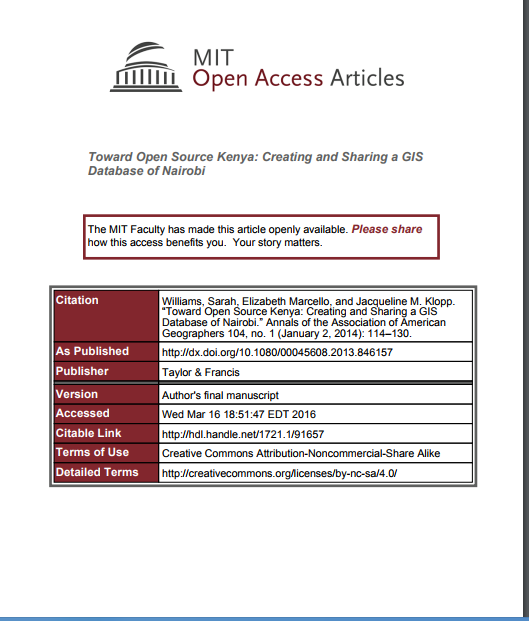
Topics and Regions
Vision
To be a centre of excellence in promoting the Formulation and application of appropriate land and natural resource policies, laws and management practices by empowering society through innovative and knowledge based advocacy and capacity building in Kenya and the region.
Mission
To contribute to transformation of society through offering a bridge between communities, stakeholders and policy makers in the promotion of equitable access and sustainable management of land and natural resources.
Goal
To contribute to the transformation of society and empowerment of the citizens through influencing, promotion and advancement of policies, procedures and tools necessary for the equitable access and sustainable management of land and natural resources.
Details
Public Email
Location
Contributions
Displaying 1 - 10 of 78REGISTRATION OF PROPERTIES IN STRATA IN KENYA
In recent years, the need to provide title to small units owned by individuals above and under the surface has been increasing. The need for more intensive development on available land, while ensuring security of tenure, has prompted various jurisdictions to search for solutions. Registration of small units is difficult in many jurisdictions due to planning regulations, which regulate minimum parcel sizes on the ground surface.
Land Management Information Systems in the Knowledge Economy
The economies of most African countries rely heavily on agriculture and other land and land-based activities such as tourism, mining and livestock production. Indeed, these are the core activities through which African countries participate in the global economy. Moreover, land is key to food security and the social-cultural needs of most communities in Africa. It has also been established that the performance of most sectors of the economies of African countries is indeed tied to that of the land sector.
Promoting Land Administration and Governance for Sustainable Development in Eastern Africa
Land administration arrangements and practices in any country influence the pace and outcomes of social and economic developments. Since the United Nations adopted the Sustainable Development Goals (SDGs), nations have been encouraged to take initiatives to attain the SDG targets. As a key factor in development therefore, how land administration arrangements and governance practices contribute to the attainment of the SDG goals becomes an important national, regional and global question.
The Kenyan Cadastre and Modern Land Administration
Despite a history of more than 100 years and the introduction of provisional maps to support land registration, the Kenyan cadastre is largely incomplete. It consists of a patchwork of maps of different positional qualities, which would not be readily integrated to create a nation-wide coverage. This paper outlines the structure of the Kenyan cadastre and analyses the quality of the cadastral maps with regard to the requirements of modern land administration.
LAND DEGRADATION ASSESSMENT IN KENYA
A summary of the findings of a study of land degradation assessment (LADA) with remote sensing (RS) and geographic information systems (GIS), and its implications for sustainable land management (SLM) in Kenya is presented. The assessment was conducted over a 6-month period in July-December 2015. The need for the LADA is in line with the Kenya Government’s strong interest in moving towards a country programmatic approach, for sustainable land management (SLM).
THE LAND LAWS OF KENYA
THE NEW LAND ACTS Pursuant to the Constitution of Kenya, three Acts of Parliament have been enacted and came into force on 2nd May, 2012: Land Act, 2012 Land Registration Act, 2012 National Land Commission Act, 2012 THE REPEALED ACTS The following Acts have been repealed: The Indian Transfer of Property Act, 1882 The Government Lands Act The Registration of Titles Act The Land Titles Act The Registered Land Act The Wayleaves Act; and The Land Acquisition Act
Changing the Use of Land in Kenya
Under the new Constitution of Kenya, 2010, the County Government is now vested with the authority to ensure that land owned by county residents is used for the purposes it has been intended for by the Director of Physical Planning established under the Physical Planning Act. This means that if you intend to buy agricultural land and convert it into commercial use, you will be forced to seek approval for this kind of change of user of the land.
Towards Kenya’s Profile of the Land Administration Domain Model (LADM)
The application of computer technology in land administration is touted as one way of ensuring efficient and transparent land administration. Although this true, one major concern is not only how to create a computerized land information system that is interoperable across different government departments responsible for different land administration functions, but also how to ensure interoperability between national and devolved levels of government departments responsible for land administration.
Towards Open Source Kenya: Creating and Sharing a GIS Database of Nairobi
In order to make good decisions about the future direction of cities we need data to contextualize
and make recommendations that are based on past results and potential models for the future. Yet
access to information including GIS is challenging, particularly as data is often seen as a
commodity or source of power by those who control it, a dynamic more severe in contexts like
Kenya. By generating GIS data for our own transportation model and then sharing it with those
VINDICATING INDIGENOUS PEOPLES’ LAND RIGHTS IN KENYA
This thesis examines the extent to which Kenya’s domestic legal framework vindicates indigenous peoples’ land rights. The question of who is an indigenous person in Kenya is, of course, controversial. In order to avoid becoming enmeshed in this debate, this thesis adopts the approach of the African Commission on Human and Peoples’ Rights, which is based on identifying the key concerns faced by marginalised communities who self-identify as indigenous peoples.










